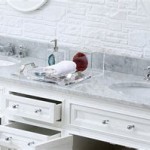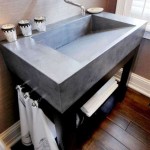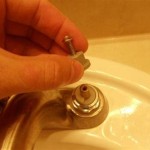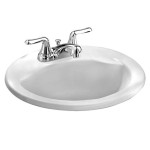Bathroom Sink Stopper Won't Move: Troubleshooting and Solutions
A bathroom sink stopper that refuses to budge is a common household plumbing issue. It can manifest as a stopper stuck in the up position, preventing the sink from holding water, or stuck in the down position, hindering drainage. This problem can stem from various causes, ranging from simple obstructions to more complex mechanical failures within the stopper mechanism. Understanding the potential culprits and implementing systematic troubleshooting steps can often resolve the issue without requiring professional plumbing assistance.
This article aims to provide a comprehensive guide to diagnosing and rectifying a stuck bathroom sink stopper. It will explore common causes, outline step-by-step troubleshooting procedures, and offer practical solutions for freeing a jammed stopper and restoring proper sink functionality. The focus will be on equipping homeowners with the knowledge and tools to address this problem effectively and efficiently.
Identifying Common Causes of a Stuck Sink Stopper
Several factors can contribute to a bathroom sink stopper becoming immobile. Accurately identifying the root cause is crucial for selecting the appropriate solution. Ignoring the underlying issue can lead to recurrence of the problem or even damage to the plumbing system.
One of the most frequent culprits is the accumulation of debris. Hair, soap scum, toothpaste residue, and other materials can gradually build up around the stopper and within the drainpipe, creating a sticky or solid mass that impedes the stopper's movement. This buildup can bind the stopper in either the open or closed position, depending on where the obstruction is located.
Another common cause is corrosion. Over time, the metal components of the stopper mechanism, particularly the linkage connecting the stopper to the control lever, can corrode due to exposure to water and cleaning products. This corrosion can cause parts to seize or become brittle, preventing the stopper from moving freely. In severe cases, corrosion can even lead to the breakage of critical components, necessitating replacement.
Mechanical failure is another potential source of the problem. The pop-up stopper mechanism, which typically involves a series of levers, pivots, and a spring, can be susceptible to wear and tear. A bent or broken linkage, a dislodged spring, or a seized pivot point can all prevent the stopper from functioning correctly. Similarly, the control lever itself, often located behind the faucet or on the sink rim, can become loose or disconnected from the linkage, rendering the stopper unresponsive to its operation.
Misalignment of the stopper mechanism can also lead to a stuck stopper. If the linkage is not properly aligned, it can bind against the drainpipe or other components, preventing the stopper from moving smoothly. This misalignment can occur due to accidental bumps, forceful operation of the control lever, or even settling of the plumbing system over time.
Finally, hard water deposits can contribute to a stuck stopper. In areas with hard water, mineral deposits can accumulate around the stopper and within the drainpipe, creating a rough surface that increases friction and impedes movement. These deposits can also corrode metal components, exacerbating the problem.
Step-by-Step Troubleshooting Procedures
When confronted with a stuck bathroom sink stopper, a systematic troubleshooting approach can help pinpoint the problem and guide the resolution process. Starting with the simplest solutions and progressing to more complex procedures minimizes the risk of unnecessary disassembly and potential damage.
The first step is to visually inspect the stopper and the surrounding area. Look for any obvious signs of debris buildup, corrosion, or mechanical damage. Check the control lever to ensure it is securely connected to the linkage and that it moves freely. Attempt to manually move the stopper up and down to gauge the degree of resistance. If the stopper moves slightly but is still difficult to operate, the problem is likely caused by a buildup of debris or corrosion.
If a visual inspection doesn't reveal the cause, the next step is to attempt to flush out any potential debris. Run hot water into the sink for several minutes, allowing it to drain slowly. The hot water can help to dissolve soap scum and loosen other debris. Simultaneously, try to operate the control lever or manually move the stopper up and down to dislodge any obstructions. Using a plunger can also help to create pressure and dislodge debris within the drainpipe.
If flushing with hot water proves ineffective, the next step is to disassemble the stopper mechanism. Locate the pivot rod, which is typically located beneath the sink and connects the control lever to the stopper linkage. Carefully loosen the retaining nut that secures the pivot rod to the drainpipe. Once the nut is loose, gently pull out the pivot rod. This will disconnect the control lever from the stopper linkage, allowing you to remove the stopper from the drain.
With the stopper removed, thoroughly inspect it for any signs of debris buildup, corrosion, or damage. Clean the stopper with a mild detergent and a scrub brush to remove any accumulated grime. Also, inspect the drain opening for any obstructions. Use a small brush or a bent wire to remove any debris from the drainpipe.
Once the stopper and drain opening are clean, inspect the linkage mechanism for any signs of corrosion, damage, or misalignment. If the linkage is corroded, clean it with a wire brush and apply a lubricant such as WD-40 to help restore its movement. If the linkage is bent or broken, it may need to be replaced.
After cleaning and inspecting all the components, reassemble the stopper mechanism, ensuring that all parts are properly aligned and securely connected. Tighten the retaining nut on the pivot rod, but avoid over-tightening, which can damage the drainpipe. Test the operation of the stopper by moving the control lever up and down. If the stopper still does not move freely, re-examine the linkage for any remaining obstructions or misalignments.
Practical Solutions for Freeing a Jammed Stopper
Once the source of the problem has been identified through troubleshooting, specific solutions can be implemented to free the jammed stopper and restore proper sink functionality. These solutions range from simple cleaning techniques to more involved repairs or replacements.
For stoppers jammed due to debris buildup, thorough cleaning is often sufficient. Remove the stopper as described in the troubleshooting steps and soak it in a solution of hot water and a degreasing detergent. Use a scrub brush or an old toothbrush to remove any stubborn grime. Clean the drain opening with a bottle brush or a flexible drain snake to remove any debris that may be lodged deeper within the drainpipe. For stubborn clogs, a commercial drain cleaner may be necessary, but it is crucial to follow the manufacturer's instructions carefully and avoid prolonged exposure to the cleaner, as it can damage the plumbing system.
For stoppers jammed due to corrosion, cleaning and lubrication are essential. Remove the stopper and other components of the linkage mechanism and thoroughly clean them with a wire brush to remove any rust or corrosion. Apply a lubricant such as WD-40 or a silicone-based lubricant to all moving parts, including the pivot points and the threads of the retaining nuts. The lubricant will help to reduce friction and restore smooth movement.
For stoppers jammed due to mechanical failure, repair or replacement may be necessary. If the linkage is bent or broken, it may be possible to straighten it with pliers or replace the damaged component. Parts for the stopper mechanism are often available at hardware stores or plumbing supply stores. If the entire stopper mechanism is severely corroded or damaged, it may be more cost-effective to replace the entire unit. Complete stopper replacement kits are readily available and typically include all the necessary components and instructions for installation.
For stoppers jammed due to misalignment, careful readjustment of the linkage mechanism is required. Loosen the retaining nut on the pivot rod and gently reposition the linkage until the stopper moves freely. Once the stopper is properly aligned, tighten the retaining nut, but avoid over-tightening. Test the operation of the stopper by moving the control lever up and down. If the stopper still does not move freely, re-examine the linkage for any remaining misalignments.
For stoppers jammed due to hard water deposits, a descaling solution can be effective. Remove the stopper and soak it in a solution of equal parts white vinegar and water. The vinegar will help to dissolve the mineral deposits. Alternatively, a commercial descaling solution can be used, following the manufacturer's instructions carefully. After soaking, scrub the stopper with a brush to remove any remaining mineral deposits. Clean the drain opening with a similar descaling solution and a brush or a flexible drain snake.
After implementing the appropriate solution, thoroughly test the operation of the stopper to ensure that it moves freely and seals properly. If the stopper still does not function correctly, re-examine the troubleshooting steps and repeat the appropriate solution. In some cases, it may be necessary to consult a professional plumber for assistance.

How To Fix A Bathroom Sink Drain Stopper 4 Easy Solutions
How To Get A Bathroom Sink Plug Removed When It Won T Un Quora
I Closed My Sink Drain Stopper And Now It Won T Open Again Is There Any Way That Can Repair This Without Hiring A Plumber Quora

How To Fix A Bathtub Or Sink Pop Up Stopper

How To Replace Or Maintain A Sink Pop Up Drain Assembly

My Pop Up Drain Is Not Draining Water

How To Replace A Sink Stopper Quick And Simple Home Repair

How To Fix A Bathroom Sink Drain Stopper 4 Easy Solutions

Bathroom Repair How To A Pop Up Tub Drain Stopper

How To Clear A Clogged Drain Reviews By Wirecutter







